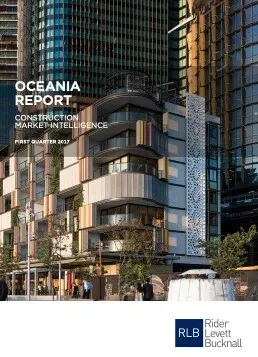The Rider Levett Bucknall Q1 2017 RLB Oceania Report released today shows the construction outlook for both Australia and New Zealand remains positive, with the residential market fuelling growth with inconsistent rises in construction costs forecasted across the region.
Non-resource sector seeing steady increase
Mr Stephen Ballesty, Director of Research & Development at RLB said, ‘With economic growth in Australia projected to pick up to 3% by 2018, the market’s positive sentiment looks set to continue. The decline in resource-sector investment has started to tail off but the non-resource sector is seeing a steady increase in household consumption and investment as wages and employment rise.’
He added, ‘Recent strong economic growth in New Zealand is projected to moderate to less than 3% in 2018. Both net migration and expenditure on the Canterbury earthquake rebuild are expected to slow gradually, slowing domestic demand, especially construction activity.’
The RLB Market Sector Activity Model
These observations are highlighted in the RLB Market Sector Activity Model, which tracks whether the houses, apartments, offices, industrial, hotel, civil and retail sectors are in a growth or decline phase. Across Oceania, of the seven sectors RLB monitors, 64% of all city’s sectors are in a growth phase, with 36% in a decline phase.
Mr Ballesty continued, ‘All market sectors within Sydney are in the growth and mid phases of the market cycle, whereas Canberra has the most sectors within the trough phase. Wellington, where six of seven sectors are in the mid growth phase, is poised for a stronger year in 2017.’
Both Melbourne and Darwin have four sectors within the peak phase, showcasing the historical construction work done performance,’ he said.
According to the report, RLB’s forecast escalation in construction costs is very mild compared to the last peak period of building work seen in 2002 to 2004, where annual construction cost escalation within the major observed cities ranged from 3.5% to 11.7%. RLB has reported escalation rises for the past three years of between 0.6% to 6.0%, which is a significant decrease from the 2002 and 2004 numbers.
Adelaide
The tender market continues to be keen but there are clear signs, with more work coming into the pipeline, the cost of construction is increasing. RLB continues to see signs of larger contractors pricing smaller projects to ensure they maintain work into 2017.
Major projects include: Adelaide University Clinical School ($230M); University of South Australia Health Innovation Building ($200M); Skycity Casino ($300M), University of South Australia Great Hall ($50M); New CBD High School Adelaide ($80M).
All trade contractors continue to remain competitive and are actively seeking new work as the year comes to an end. With the prospect of more work becoming available in 2017, there is an expectation that costs will rise.
Brisbane
The lack of job opportunities in Queensland following the resource sector downturn has resulted in the population remaining static.
The long-awaited commencement of the Queens Wharf project will occur in early 2017 with the demolition of the government buildings. The State Government announced Australian Unity as the preferred proponent for the redevelopment of the Herston Quarter. This will see a major health, research and aged care precinct developed on the site of the old Children’s Hospital site.
Many major commercial projects were completed in 2016: 1 William Street, 480 Queen Street and 160 Ann Street. This has resulted in historically high commercial vacancy rates in both Brisbane CBD and Fringe markets. With commercial buildings at Southpoint and 900 Ann Street yet to come, this situation is likely to get worse before it improves.
Canberra
Capital Metro Light Rail has commenced initial works on Northbourne Ave. The Australian National University (ANU) recently awarded the circa $160M Union Court project to Lend Lease. This will revitalise the heart of the university campus while providing new learning, teaching, social and community facilities.
The new ANU 800-bed student accommodation project will start towards the end of the year along with other key education projects. There is strong sentiment in the residential market with the proposed $500M “Section 200” mixed-use development in Belconnen, a development to be staged over the next 10 years. There has been an increase in dwelling unit approvals of approximately 14% from the previous year.
Darwin
The market has essentially been flat this year with very little pickup expected for 2017. Construction of the Inpex LNG plant will be continuing throughout 2017 and no major replacement project is expected upon its completion leading potentially to further market instability. It is likely that some Defence projects may commence, which will infuse activity in the construction sector.
Gold Coast
The recent introduction of the 3% surcharge on stamp duty for foreign investors together with tightening of the lending industries financing requirements has led to a general easing of the Gold Coast construction industry. There appears to be a perceived drop in developer confidence, with many large scale residential projects stalling and not proceeding beyond Development Approval stage.
On a positive note, there has been a substantial increase of both international and interstate visitors to the Gold Coast. This is driving investment in tourism facilities such as hotels and ongoing retail upgrades and developments.
Projects underway include; Stage 2 of the Light Rail to link Helensvale heavy rail at the Gold Coast University Hospital station, the $300M Gold Coast airport expansion, the $1B Jewel Project and the 89-storey Spirit residential Tower in Surfers Paradise, the new high-rise hotel at Jupiter’s Casino, and the Commonwealth Games venues are progressing well.
Costs of trades increasing
The increase in construction activity has led to an increase in the costs of trades such as formwork, tiling and plasterboard partitions. We are also seeing the ongoing influence of the lower Australian dollar on the cost of imported materials and equipment with trades such as lifts, mechanical, aluminum windows and doors and white goods.
Melbourne
Major projects such as Melbourne’s new Metro Tunnel and the Western Distributor are ready to proceed after the State Government announced they intend to fund these projects without assistance from the Federal Government.
Labour rates are still fluctuating. On detached housing sites, labour is inching up slightly in the ‘hard’ trades i.e. bricklayers and carpenters. Within large commercial and residential projects, the volume of overtime is diminishing, causing a net constant pricing of labour within the project.
Small decreases in steel costs have shown up in the tender market during the past quarter. This is due to the reduction in base cost from China and companies attempting to secure pipeline for the future. Tendering is described as aggressive while contractors are trying to secure work with building costs remaining relatively stable.
Perth
The Perth office vacancies are at historically high levels at 22% in the Perth CBD and construction in the office sector is likely to remain low for a period. The residential sector has been strong over the last few years, but is now slowing on the back of slower pre-sales and slowing population growth. The retail sector (major shopping centres) have significant capital works planned over the next few years.
The State Government has awarded the $2B Forrestfield Link, a new train line that will connect the city with Perth Airport and a new terminus at this eastern suburb. The contract for design and construction has been awarded to a joint venture led by the Italian industrial group, Salini Impreglio.
The government is also proceeding with the Perth Freight link. This $1.6B project is a major infrastructure project to enhance freight movement to Fremantle Ports. Despite five years without any measurable construction price increase, the current depressed work volumes have continued to keep price levels flat across most sectors.
Sydney
Recent comments from economic analysts have noted that NSW is the top economic performing state in Australia. Activity in the Sydney construction market continues to be a major contributor to the economic performance of the state.
The Barangaroo South and International Convention Centre developments are now nearing completion, however subcontractors and suppliers appear to be able to source new replacement work in other sectors.
Work in the education, health, and aged-care sectors are of significant interest to contractors. Concrete and masonry supply prices increased by 5% in the second quarter of 2016, while steel and plasterboard products increased by approx 3% in the third quarter. Most other building material prices remained stable over the year to date.
Market experiencing labour shortage
While the supply cost of building materials has remained steady, the cost of labour has continued to increase. All sectors of the industry are reporting increased demands for wage increases up to 5% per annum. These increases are being passed on to the cost of construction. The Sydney market is now also experiencing labour shortage in reinforcement fixers, form workers, bricklayers, carpenter/joiner and fire protection trades, with these trades reporting full order books and unable to accept new opportunities.
Contractors are being forced into seeking alternative sources of subcontractor procurement. In response to increasing wages and scarce resources, contractors and designers are continuing to take an increased interest in prefabricated methods of construction in order to overcome labour shortages and increase efficiency on site.
Increased cost pressures for 2017
The availability of trades pricing new projects for contractors compiling tender offers is becoming a significant risk issue within the market due to levels of work. The strong fundamentals for a continuing strong work load throughout 2016 and into 2017 indicate construction prices will increase in the range of 4.5% to 5% in 2016. Current indicators of current strong work load and the opportunity for further increased work in the first half of 2017 may lead to increased cost pressure due to the competition for scarce resources to complete work that is in hand.
Townsville
2017 is shaping up to be the start of recovery in major activities in the Townsville region. The Townsville Waterfront Priority Development Area will deliver a great opportunity for the revitalisation of the CBD. The North Queensland Stadium and Entertainment precinct project (commencing construction in 2018) will also provide a catalyst for further CBD renewal.
But the biggest impact is that Townsville is likely to become the headquarters for the Carmichael coal mine project. It is expected that the wider North Queensland region will also benefit from this.
FURTHER INFORMATION:



